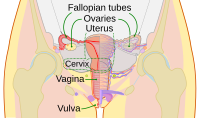Vaginal canal
| Vagina | |
|---|---|

Diagram of the female human reproductive tract and ovaries
|
|

Vulva with pubic hair removed and labia separated to show the opening of the vagina
1: Clitoral hood 2: Clitoris 3: Labia minora 4: Urethral opening 5: Vaginal opening 6: Perineum 7: Anus |
|
| Details | |
| Precursor | urogenital sinus and paramesonephric ducts |
| Artery | superior part to uterine artery, middle and inferior parts to vaginal artery |
| Vein | uterovaginal venous plexus, vaginal vein |
| Nerve | Sympathetic: lumbar splanchnic plexus Parasympathetic: pelvic splanchnic plexus |
| Lymph | upper part to internal iliac lymph nodes, lower part to superficial inguinal lymph nodes |
| Identifiers | |
| Latin | Vagina |
| MeSH | A05.360.319.779 |
| Dorlands /Elsevier |
Vagina |
| TA | A09.1.04.001 |
| FMA | 19949 |
|
Anatomical terminology
[]
|
|
In mammals, the vagina is a and tubular part of the female genital tract, which, in humans, extends from the vulva to the cervix. The outer vaginal opening may be partly covered by a membrane called the hymen. At the deep end, the cervix (neck of the uterus) bulges into the vagina. The vagina allows for sexual intercourse and childbirth, and channels menstrual flow, which occurs periodically as part of the menstrual cycle.
The vagina has been studied in humans more than it has been in other animals. Its location and structure varies among species, and may vary in size within the same species. Female mammals usually have the opening of the urethra of the urinary system separate to the vaginal opening of the genital tract. This is different to male mammals, who usually have a single opening, the external urethral opening for both urination and reproduction. The vaginal opening is much larger than the nearby urethral opening, and both are protected by the labia in humans. In amphibians, birds, reptiles and monotremes, the cloaca is the single external opening for the gastrointestinal tract and the urinary and reproductive tracts.
To accommodate smoother penetration of the vagina during sexual intercourse or other sexual activity, vaginal moisture increases during sexual arousal in human females and also in other female mammals. This increase in moisture is vaginal lubrication, which reduces friction. The texture of the vaginal walls creates friction for the penis during sexual intercourse and stimulates it toward ejaculation, enabling fertilization. Along with pleasure and bonding, women's sexual behavior with others (which can include heterosexual or lesbian sexual activity) can result in sexually transmitted infections (STIs), the risk of which can be reduced by recommended safe sex practices. Other disorders may also affect the human vagina.
...
Wikipedia
